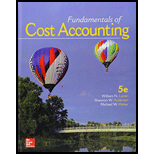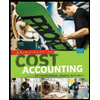
Fundamentals of Cost Accounting
5th Edition
ISBN: 9781259565403
Author: William N. Lanen Professor, Shannon Anderson Associate Professor, Michael W Maher
Publisher: McGraw-Hill Education
expand_more
expand_more
format_list_bulleted
Question
Chapter 8, Problem 16CADQ
To determine
Determine the need to treat prior period costs differently for evaluation purposes from direct material costs purchased from another firm.
Expert Solution & Answer
Want to see the full answer?
Check out a sample textbook solution
Students have asked these similar questions
Please provide the answer to this general accounting question using the right approach.
I am searching for the accurate solution to this general accounting problem with the right approach.
D&G ENTERPRISES ISSUES BOND WITH A
$1,000 FACE VALUE THAT MAKES COUPON
PAYMENTS OF $10 EVERY 3 MONTHS. WHAT
IS THE COUPON RATE?
A. 1%
B. 4%
C. 6%
D. 8%
E. 12%
Chapter 8 Solutions
Fundamentals of Cost Accounting
Ch. 8 - What are the characteristics of industries most...Ch. 8 - A manufacturing company has records of its...Ch. 8 - If costs increase from one period to another, will...Ch. 8 - What are the five steps to follow when computing...Ch. 8 - What is the distinction between equivalent units...Ch. 8 - Which method, weighted-average or FIFO, better...Ch. 8 - It has been said that a prior departments costs...Ch. 8 - The more important individual unit costs are for...Ch. 8 - Assume that the number of units transferred out of...Ch. 8 - The management of a liquid cleaning product...
Ch. 8 - We have discussed two methods for process costing,...Ch. 8 - A friend owns and operates a consulting firm that...Ch. 8 - The controller of a local firm that uses a...Ch. 8 - Throughout the chapter, we treated conversion...Ch. 8 - Consider a manufacturing firm with multiple...Ch. 8 - Prob. 16CADQCh. 8 - Would process costing work well for a service...Ch. 8 - Compute Equivalent Units: Weighted-Average Method...Ch. 8 - Compute Equivalent Units: FIFO Method Refer to the...Ch. 8 - Compute Equivalent Units: Weighted-Average Method...Ch. 8 - Compute Equivalent Units: FIFO Method Refer to the...Ch. 8 - Compute Equivalent Units Magic Company adds...Ch. 8 - Equivalent Units: Weighted-Average Process Costing...Ch. 8 - Compute Equivalent Units: Ethical Issues Aaron...Ch. 8 - Equivalent Units and Cost of Production By...Ch. 8 - Compute Costs per Equivalent Unit:...Ch. 8 - Prob. 27ECh. 8 - Compute Equivalent Units: FIFO Method Materials...Ch. 8 - Compute Equivalent Units and Cost per Equivalent...Ch. 8 - Cost Per Equivalent Unit: Weighted-Average Method...Ch. 8 - Compute Costs per Equivalent Unit:...Ch. 8 - Prob. 32ECh. 8 - Compute Costs per Equivalent Unit: FIFO Method...Ch. 8 - Prob. 34ECh. 8 - Compute Costs per Equivalent Unit:...Ch. 8 - Assign Costs to Goods Transferred Out and Ending...Ch. 8 - Prob. 37ECh. 8 - Assign Costs to Goods Transferred Out and Ending...Ch. 8 - Prepare a Production Cost Report: FIFO Method...Ch. 8 - Prepare a Production Cost Report: Weighted-Average...Ch. 8 - Prepare a Production Cost Report: Weighted-Average...Ch. 8 - Prepare a Production Cost Report: FIFO Method...Ch. 8 - Cost of Production: Weighted-Average and FIFO...Ch. 8 - Operation Costing: Ethical Issues Brokia...Ch. 8 - Prob. 45ECh. 8 - Prob. 46PCh. 8 - Prob. 47PCh. 8 - Prob. 48PCh. 8 - Prob. 49PCh. 8 - Prob. 50PCh. 8 - Prob. 51PCh. 8 - Prepare a Production Cost Report and Show Cost...Ch. 8 - Prob. 53PCh. 8 - Prob. 54PCh. 8 - Prepare a Production Cost Report: Weighted-Average...Ch. 8 - Prob. 56PCh. 8 - Prob. 57PCh. 8 - Prob. 58PCh. 8 - Prob. 59PCh. 8 - Process Costing and Ethics: Increasing Production...
Knowledge Booster
Similar questions
- Can you help me solve this general accounting question using the correct accounting procedures?arrow_forwardI am looking for a reliable way to solve this financial accounting problem using accurate principles.arrow_forwardCan you explain the correct approach to solve this general accounting question?arrow_forward
- Can you demonstrate the proper approach for solving this financial accounting question with valid techniques?arrow_forwardCan you solve this general accounting problem using accurate calculation methods?arrow_forwardA company had an income of $60,000 using absorption costing for a given period. Beginning and ending inventories for that period were 13,000 units and 18,000 units, respectively. Ignoring income taxes, if the fixed overhead application rate was $3.00 per unit, what was the income using variable costing? A. $75,000. B. $60,000. C. $45,000. D. Not sufficient information to determine.arrow_forward
- Can you solve this general accounting problem with appropriate steps and explanations?arrow_forwardAn asset has a book value of $22,500 on December 31, Year 4. The asset has been depreciated at a straight-line rate of $5,000 per year. If the asset is sold on December 31, Year 4 for $19,000, what should the company record? • a. A loss on sale of $3,500 • b. A gain on sale of $3,500 . c. Neither a gain nor a loss is recognized . • d. A loss on sale of $1,000 e. A gain on sale of $1,000arrow_forwardThe audited accounts of Rattle Limited for year-end December 31, 2013, show a profit of $2,400,000 after charging the following: Depreciation $380,000 Legal fees $723,000 Bad debts $67,000 Donations $55,400 Accrued interest $51,000 Foreign travel $75,000 Repair and maintenance $216,000 Premium on insurance $88,000 Other Information: a. - Legal fees of $723,000 are for expenses in respect of the recovery of debts. b. - The company made donations of $55,400 to a registered charity. c. - The bad debt expense is a percentage of debtors at year-end. d. - Foreign travel expense was for a trip by the marketing manager to meet with potential buyers. e. - The capital allowances have been calculated at $142,000 f. - The premium paid of $88,000 was on insurance for the business’ property. g. - There were acquisition expenses of $45,000 associated with the expansion of the business. What is Rattle Ltd.’s corporate tax liability?…arrow_forward
- A company's income statement for September reports a net income of $75,000. During the same month, the company paid $15,000 in dividends. If the beginning stockholders' equity was $0, what is the ending balance in stockholders' equity?arrow_forwardI need the correct answer to this general accounting problem using the standard accounting approach.arrow_forwardI need help with this general accounting question using standard accounting techniques.arrow_forward
arrow_back_ios
SEE MORE QUESTIONS
arrow_forward_ios
Recommended textbooks for you
 Principles of Cost AccountingAccountingISBN:9781305087408Author:Edward J. Vanderbeck, Maria R. MitchellPublisher:Cengage LearningPrinciples of Accounting Volume 2AccountingISBN:9781947172609Author:OpenStaxPublisher:OpenStax College
Principles of Cost AccountingAccountingISBN:9781305087408Author:Edward J. Vanderbeck, Maria R. MitchellPublisher:Cengage LearningPrinciples of Accounting Volume 2AccountingISBN:9781947172609Author:OpenStaxPublisher:OpenStax College Managerial AccountingAccountingISBN:9781337912020Author:Carl Warren, Ph.d. Cma William B. TaylerPublisher:South-Western College Pub
Managerial AccountingAccountingISBN:9781337912020Author:Carl Warren, Ph.d. Cma William B. TaylerPublisher:South-Western College Pub Financial And Managerial AccountingAccountingISBN:9781337902663Author:WARREN, Carl S.Publisher:Cengage Learning,
Financial And Managerial AccountingAccountingISBN:9781337902663Author:WARREN, Carl S.Publisher:Cengage Learning,

Principles of Cost Accounting
Accounting
ISBN:9781305087408
Author:Edward J. Vanderbeck, Maria R. Mitchell
Publisher:Cengage Learning

Principles of Accounting Volume 2
Accounting
ISBN:9781947172609
Author:OpenStax
Publisher:OpenStax College

Managerial Accounting
Accounting
ISBN:9781337912020
Author:Carl Warren, Ph.d. Cma William B. Tayler
Publisher:South-Western College Pub

Financial And Managerial Accounting
Accounting
ISBN:9781337902663
Author:WARREN, Carl S.
Publisher:Cengage Learning,